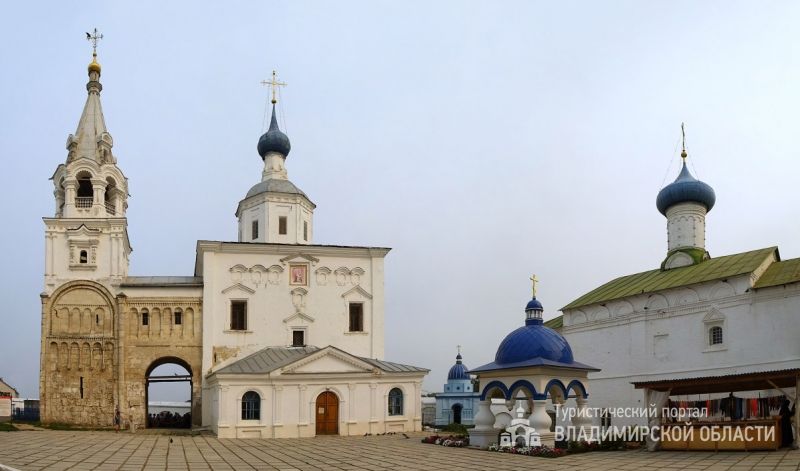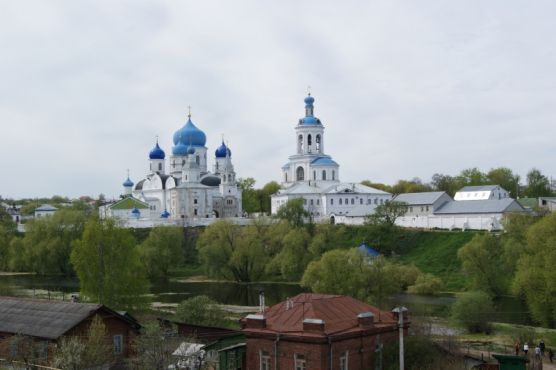Staircase Tower in Bogolyubov-town
In the settlement of Bogolyubovo preserved monuments relating to the period of the reign of Andrey Bogolyubsky. The transfer of the center of Russian statehood from Kiev to the city of Vladimir is connected with his name.
Andrey Bogolyubsky (about 1111-1174) is the grandson of Vladimir Monomakh, the eldest son of Yury Dolgoruky. His youth was overshadowed by the struggle of his father and his brothers for the great Kiev reign. After the death of Yury Dolgoruky in 1157, Andrew inherited the throne of Kiev, but did not go to Kiev to avoid civil strife, but set off to the northeastern Russian lands.
The princely town of Bogolyubov was built during the same period (1158-1165), when the new capital of the Rostov-Suzdal principality, Vladimir, was settled. The transfer of the capital to Vladimir was a blow to the independence of the old boyar nobility with its local interests, which was grouped around Rostov and Suzdal. In the struggle for political domination, it was of strategic importance to have access to river routes – from Nerl to Klyazma, then to Oka and Volga. Here, on the high Klyazma shore, from which the mouth of the Nerl river was visible, a new princely fortress and a magnificent residence – Bogolyubov-town – were built.
According to the idea of Andrey Bogolyubsky, it was a small but well-fortified castle, surrounded by powerful earthen ramparts (the width in the base was up to 20 m, the height was up to 6 m, the perimeter was 800 m). Over the ramparts were erected stone walls with battle towers. During the excavations of 1934-1954, in the southern slope of the fortress were found the remains of the base of a perfectly built of hewn white stone wall or tower. Behind the ramparts there were moats filled with water.
To soften the discontent of the old boyar nobility with the creation of a new princely residence, clergy loyal to the prince invented a "miracle": as if when Andrey moved from the south to Rostov-Suzdal land, the horses carrying the miraculous icon of the Mother of God (the prince took it out of the Vyshgorod convent) stood in the place of the future Bogolyubov as stone-still. The prince ordered to spend the night here. During the dream, the Mother of God appeared to him in the tent. She forbade him to take the icon to Rostov and prayed for Vladimir's land and the prince himself, taking him under her protection. The plot of this legend was imprinted in the large icon of the Bogolyubov Mother of God ordered by Andrey (since 1992 it is kept in the Assumption Cathedral of the Princess Monastery in Vladimir), which by its expressiveness and beauty was not inferior to the Byzantine icon (the Vladimir Mother of God). Therefore, the new prince's town was called Bogolyubov ("a place beloved by God"), and prince Andrey himself – Bogolyubsky.
For the construction of the palace and the temple, prince Andrey invited masters from different countries: from Constantinople, from the far Caucasus and even from the German Emperor Frederick I Barbarossa. Very little survived from the ancient palace ensemble. But chronicles and excavation materials give interesting information about it.
In 1158 in the center of the princely court a white-stone cathedral of the Nativity of the Virgin was built, which amazed contemporaries with luxury and beauty. Carved stones of the facade with female masks, differing in each other's facial expressions and associated with the dedication of the temple of the Mother of God, were found during the excavations. From the hewn of white stone gutters, laid between the zakomars of the cathedral, there was found a sculpture – the head of a dog or a dragon, which was placed on the top of the tray. The architectural fragments and layers of frescos found during excavations are exhibited in an exposition located in the Nativity Cathedral, which was built on the site of an ancient church in the middle of the 18th century.
The previous cathedral of the 12th century collapsed in 1722 due to an attempt to break through the walls for large windows to increase the flow of light from the outside. Fortunately, a part of its northern wall survived, retained by the ancient passage adjoining it and connecting with the staircase tower (in the 12th century, with the help of towers and galleries, the temple was communicated with living quarters of the prince and with the fortress). These parts of the ancient structure were preserved as a revered place: here prince Andrey Bogolyubsky was killed.
The Staircase Tower (restored in 1963) is a witness of the tragedy that took place on the night of June 28-29, 1174. The conspiracy arose after the execution by order of Andrey Bogolyubsky of his first wife Ulita’s brother for some atrocities. The other brothers, led by Peter Kuchkovitch, came to the bedchamber of the prince. Wounded by the conspirators from among his close ones, bleeding to death, prince Andrey slid down the steps of the staircase tower, disappeared into the niche behind the pillar, but was killed by murderers. About the events of this night and the subsequent days of the uprising in Vladimir and Bogolyubov, with astonishing realism tells a man close to the prince, the Vyshgorod priest Mikula in the story about the murder of Andrey. However, this tragic event of the 12th century for a long time remained one of the most mysterious.
At the end of 2015 it became known about the astonishing discovery of scientists from the Institute of Archeology of the Russian Academy of Sciences: during the restoration of the Transfiguration Cathedral in Pereslavl-Zalessky (in the second half of the 12th century it was part of the Vladimir-Suzdal Principality), graffiti with a list of 20 conspiracies was found in the middle of the southern apse. Probably, it was an official text for the edification of the descendants, and it is quite possible that similar inscriptions can be found in the temples of the 12th century in Vladimir.
Andrey Bogolyubsky was buried in the Vladimir Assumption Cathedral. In 1702, the church ranked him as a saint. In 1934, his burial was examined and identified by archaeologists and anthropologists. On the skull found in the burial, M.M. Gerasimov managed to recreate the unique sculptural portrait of Andrey Bogolyubsky.
The white-stone transition (gallery) and part of the staircase of the 12th century that has survived to the present day, as well as excavation materials, allow us to make some assumptions about the original appearance of the princely palace ensemble. Today, ancient fragments are easily recognized by stone ornaments reminding of the reliefs of the Church of the Intercession on the Nerl. These structures are a rare example of the secular architecture of pre-Mongol Rus and in 1992 were included in the UNESCO World Heritage List.
Now on the site of Bogolyubov-town is located the current Holy Bogolyubsky Women's Monastery. If viewed from the side of the village of Bogolyubovo, the three-tiered bell tower and the five-domed cathedral of the Bogolyubsky icon of the Mother of God built in the middle of the 19th century dominate its modern appearance. Due to the bright blue color of the domes and white walls, the whole complex of the monastery looks solemn and beautiful.
 Tourism portal of the
Tourism portal of the
